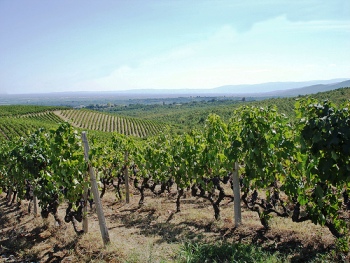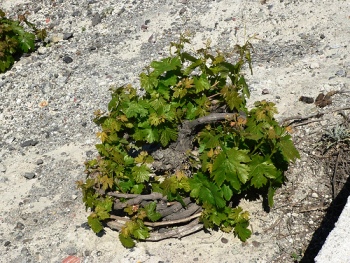
Wine has been part of the Greek lifestyle for over 4,000 years. The ancient Greek knew about the wine and spread the word to other parts of Europe and even in Africa. Currently, the wine making industry in Greece has undergone incredible improvements and , as a result, the Greek wines continue to get the highest awards in international competitions.
History of wine making in Greece
The history of wine spans through thousands of years of history and is directly linked to the history of civilization, agriculture and humanity. Evidence suggests that the earliest wine production comes from sites in Iran and Georgia (dating back as far as 6,000 or 5,000 BC). In Europe, evidence shows the earliest wine production in Macedonia (some 6,500 years ago).
Wine was very common in ancient Greece. The exact arrival of wine in Greece is not known but wine was common in both Minoan and Mycenaean cultures. Even today, many grapes grown in Greece are similar (or even identical) to the varieties grown in ancient times. The popular white (or sometimes rose) wine Retsina is believed to be a consequence of the time when wine jugs were lined with tree resin, hence implanting a distinct flavor to the liquor.
In archaeological sites in Greece, scientists discovered 6,500 year-old grape remnants, which are considered to be evidence of the earliest known appearance of wine production in Europe. Ancient sources reveal that partly dehydrated gypsum was used before fermentation to reduce acidity. Also, after fermentation, some type of lime was used for the same purpose.
In the Greek mythology, wine is usually served in “mixing bowls” and was referred to as “Juice of the Gods”. Dionysus, the Greek god of revelry and wine, was also known as Bacchus.
Read more about:
>> Greek Gods
>> History of Greece
Wine making regions in Greece
There are more than 300 indigenous grape varieties in Greece and many have been cultivated here since ancient times.
Macedonia

Macedonia is one of the oldest wine-making regions in the entire world. At the turns of the last century, a the catastrophic phylloxera attack slowed down the development of the wine here but after the vines were replanted and new technology used in the wine making process, the wines made here regained their appreciation worldwide.
Naoussa (on Mount Vermion) was the first wine making region to the registered in Greece. It produces full-bodied red wines made from the native grape, Xinomavro. The same variety is also cultivated in the region of Amynteon, where it produces light, fruity reds and pleasant sparkling and still rosés.
Sterea Ellada (Attica)
Sterea Ellada is one of the oldest wine making regions in Greece. Here, Dionysus introduced the culture of wine to the Greeks. In the vineyards here, we can find both indigenous and international grape varieties which adapted to the local soil.
Epirus
Epirus (Mt. Pindos) produces some of the best wines in the region, although it’s very difficult to reach the vineyards. Cabernet Sauvignon grapes were first introduced to Greece in this region.
Thessalia
The region of Rapsani (Mt Olympos) is blessed with a unique climate thanks to the mountain and the Aegean Sea. It produces the unique Rapsani red wines, made from the indigenous Xinomavro, Krassato and Stavroto grapes.
Peloponnese
Homer made the first reference to wine in the region of Peloponnese. Nemea (near Nafplion) is the most important wine making region in southern Greece for the production of red wines. Agiorghitiko grape is grown here and produces wines famous all over the world for their red color, complex aroma and velvety palate. On the hillsides, the Moschofilero grape is cultivated.
In the region of Patras dry white wines are produced from the Roditis grape. The same region offers two excellent white dessert wines (Moschato Patron and Moschato Rio of Patras). The Mavrodaphne and Korinthiaki grapes make Mavrodaphne, a fortified red wine.
Aegean Islands
The wine making tradition on the Aegean Islands goes back to the Neolithic ages. The mild weather, combined with the volcanic soil, year-round sunshine and constant sea breezes provides excellent conditions for growing vines.
 The wine production in Santorini dates back to the Bronze Age. After the devastation volcanic eruption, the soil was covered with ash, lava and pumice stone, which made the soil ideal for cultivating grapes. The grapes are cultivated in low basket shape crowns, on the ground which make Santorini wines unique in the world. The following grapes are grown here: Assyrtiko – multi purpose white grape – , Athiri – one of the most ancient grapes, used for sweet wines-, Aidani – another ancient grape.
The wine production in Santorini dates back to the Bronze Age. After the devastation volcanic eruption, the soil was covered with ash, lava and pumice stone, which made the soil ideal for cultivating grapes. The grapes are cultivated in low basket shape crowns, on the ground which make Santorini wines unique in the world. The following grapes are grown here: Assyrtiko – multi purpose white grape – , Athiri – one of the most ancient grapes, used for sweet wines-, Aidani – another ancient grape.
Rhodes was one of the regions were grapes were cultivated since ancient times. The dominant wines grown here are the white Athiri and the red Mandelaria (locally known as Amorgiano). Muscat grapes are also grown here. The wines made here are both white and red.
The wine making tradition in Crete goes back to the Minoan civilization. The oldest wine press in the world was discovered in the village of Archanes, on Crete. The most popular grapes grown here are Vilana, Kotsifali, Mandelaria and Liatico and they produce Archanes, Peza, Dafnes and Sitia wines. Chardonnay, Syrah, Plyto, Dafni and Thrapsathiri varieties are also grown on the island.
Ionian Islands
Cephalonia is the most important of the Ionian Islands when it comes to wine production. The following grapes are cultivated here: Tsaoussi and Robola grapes, Mavrodaphne and white Muscat.
Photo credits: At the vineyard ; Macedonia vineyard ; Santorini grape vine


